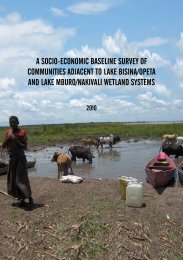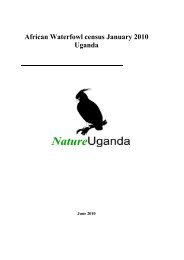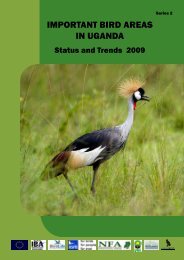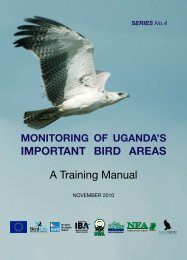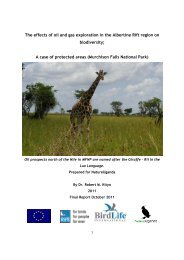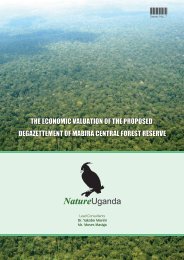A Ecological Baseline Surveys Of: - Lake Bisina - Nature Uganda
A Ecological Baseline Surveys Of: - Lake Bisina - Nature Uganda
A Ecological Baseline Surveys Of: - Lake Bisina - Nature Uganda
Create successful ePaper yourself
Turn your PDF publications into a flip-book with our unique Google optimized e-Paper software.
4.3.4 Ecosystems challenges<br />
This ecosystem has been modified through:- Over grazing; siltation and poor farming methods and<br />
fishing. This is expected to change the ecosystem and the anticipated adverse impacts include:<br />
wetland loss, siltation, floods, species loss, and soil fragility.<br />
.<br />
4.3.5 Environmental and vegetation management<br />
The massive collection of silt affect the seed bank in the soil and most annuals will die. To control<br />
siltation along the plains, there is need to make contours along the slopes to reduce on the amount<br />
of silt from the slopes that drain into the plains. Plant cover may have a priority in any effort to<br />
improve on water management, infiltration, biomass production and soil conservation. Many herbs<br />
tend to be annuals and this means that during the unfavourable or dry seasons, many species will<br />
die leaving a lot of exposed patches which at the beginning of the dry season suffer a lot of erosion.<br />
Also due to trampling by animals grazing and access to watering points, too much exposure to<br />
the scorching sun of the dry season, the exposed soil may degrade in quality through too much<br />
water loss and hardening. This could affect the soil seed bank, leaving these exposed patches<br />
permanently bare or with scanty vegetation during the wet season.<br />
4.3.6 Monitoring indicators and regimes<br />
The monitoring indicators and regimes will be indirectly through, water quality changes, soil erosion<br />
levels, plant species diversity change and any environmental changes must be observed and reacted<br />
upon. The indicator species that should be used include; Cyperus papyrus, C. articulatus, Leersia<br />
hexandra, Limnophytum angolense, Caldesia reniformis, Wisneria filifolia (these will die with less<br />
water and silting). If the water levels increase, marsh or seasonally flooded species like Echinochloa<br />
pyramidalis will die. The seed bank will be washed away into the lake and these will all die.<br />
4.3.7 Discussion<br />
<strong>Lake</strong> <strong>Bisina</strong> and <strong>Lake</strong> Opeta have rich diversity of species and with some localised rare plant<br />
species like Ottellia fischeri and Suddia sagittifolia. The Suddia sagitifolia though not sighted during<br />
the study is confirmed to be present at the site based on Herbarium material. The Suddia sagitifolia<br />
was until recently believed to be limited to southern Sudan but it has now been established that this<br />
plant also occurs in <strong>Uganda</strong> in the <strong>Lake</strong> Kyoga Basin.<br />
The threats here include: over-fishing, poor farming methods like overgrazing, and low levels of<br />
environmental awareness may all be contributing to the deterioration of the ecological system of<br />
<strong>Lake</strong> <strong>Bisina</strong>-Opeta wetland system. Increased flood risk within the catchment due to erosion from<br />
the mountains and siltation within the systems has reduced the ability to absorb flood waters.<br />
This might be partly due to overpopulation, weak enforcement of existing regulations and lack of<br />
enforceable policies and reasonable management measures.<br />
4.3.8 Conclusions and recommendations<br />
The different degradation treatments had significant effects on species composition, plant cover and<br />
species diversity, and thus affect the ecological function of plant communities. Therefore, decisions<br />
and strategies such as flood control, re-vegetation planning, species selection and seedling<br />
management should be carefully considered. Replanting with native dominant plant species or<br />
natural restoration is a reasonable choice for re-vegetation. Other interventions such as boundary<br />
marking, wetlands restoration, wise use of resources and promotion of some income generating<br />
activies (eco-tourism) should be considered for the whole landscape.<br />
<strong>Ecological</strong> <strong>Baseline</strong> <strong>Surveys</strong> of <strong>Lake</strong> <strong>Bisina</strong>, <strong>Lake</strong> Opeta, <strong>Lake</strong> Mburo and Nakivali Wetlands Systems 71



